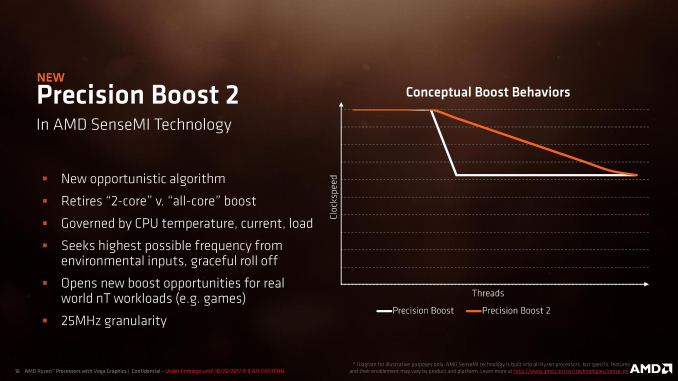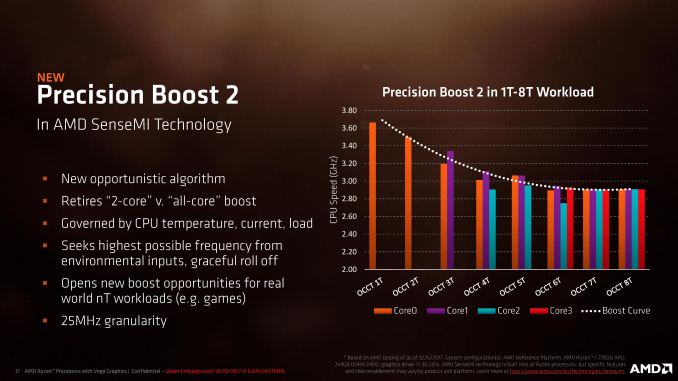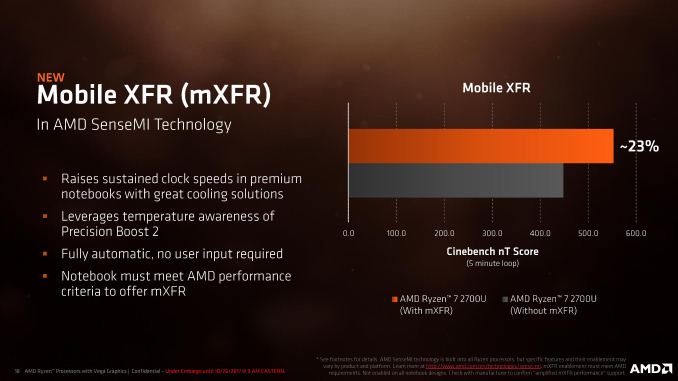Ryzen Mobile is Launched: AMD APUs for Laptops, with Vega and Updated Zen
by Ian Cutress on October 26, 2017 9:00 AM ESTSense Me Ryzen: Better Boost
When AMD launched the desktop Zen processors, it also branded a series of five technologies under the ‘SenseMI’ name. We covered these in detail in our Ryzen 7 review, but in short, it covers the following:
- Pure Power: Sensors to optimize power consumption
- Precision Boost: Determines how Turbo is applied
- Extreme Frequency Range: Going above maximum turbo when possible
- Neural Net Prediction: Using Neural Nets for prefetching data
- Smart Prefetch: Algorithms that work to enhance prefetch
With Ryzen Mobile, the features relating to frequency get an updated model, while Pure Power gets a bigger boost. We’ll cover the power changes on the next page, but it is worth talking about how AMD has improved Precision Boost and brought XFR to laptops.
Precision Boost 2
Most CPU turbo algorithms work by sensing how many cores and threads are under load, determining if the CPU has enough power headroom, and applying a voltage. This is why in the past both of the major x86 CPU manufacturers will quote a ‘per-core turbo frequency’ to show what the frequency should be when different numbers of cores are loaded and all else is fine (there is temperature/power headroom).
For Ryzen Mobile, AMD is pivoting to a new turbo model. When the system is in the P0 (top) turbo state, the system will use a new opportunistic turbo algorithm that rather than being based on the cores under load, is governed by CPU temperatures, currents, and how much load is being applied. The algorithm takes into account all the environmental inputs, such as skin temperature sensors and battery life, and will provide the best turbo frequency it can, regardless of if one thread is being used or all threads are being used.
It will be able to provide boost amounts at the 25 MHz granularity level, similar to how the desktop processors work, with the idea being that in most cases, if the system has a lot of cores available and a background process performs some very light work (such as checking for updates), rather than dropping 500-800 MHz because more cores are loaded, the system will keep at the high frequency.
AMD is stating that this has a big effect on real-world workloads, typically those that have variable thread workloads such as gaming.
When asked if Precision Boost 2 would be coming to the next generation of AMD’s Desktop Ryzen processors, I was told that ‘it could be inferred / it’s a safe bet’.
Mobile Extended Frequency Range (mXFR)
Because mobile systems are thermally limited, battery limited, power limited, and battery limited, offering ‘extra’ turbo headroom is not really something that processor manufacturers like to do. As a result, most of the Ryzen Mobile-powered notebooks will not have any form of XFR – AMD will be allowing it on a case-by-case basis for vendors that overengineer their chassis to be capable of supporting a higher power profile.
This feature essentially extends the average level at which Precision Boost 2 will operate, and also marks what could be considered a higher configurable TDP. One of the systems being launched with Ryzen Mobile this side of Christmas will be mXFR enabled, because the chassis is designed for 25W rather than 15W. It is worth noting that AMD states the configurable TDP of the Ryzen Mobile chips goes up to 25W, so this is likely the case what is happening.
Encode and Decode
AMD is fully using Vega’s encode and decode capabilities with Ryzen Mobile. The big inclusion for AMD’s mobile devices is the ability to decode VP9, the codec prefered in particular by YouTube.
| AMD Ryzen Mobile Encode/Decode Capabilities | |||||
| Decode 1080p @ 4:2:0 |
Decode 2160p @ 4:2:0 |
Encode 1080p |
Encode 1440p |
Encode 2160p |
|
| MPEG2 | 60 FPS | - | |||
| VC1 | 60 FPS | - | |||
| VP9 8/10 bpc | 240 FPS | 60 FPS | |||
| H.264 8 bpc | 240 FPS | 60 FPS | 120 FPS | 60 FPS | 30 FPS |
| H.264 10 bpc | 240 FPS | 60 FPS | |||
| HEVC 8bpc | 240 FPS | 60 FPS | 120 FPS | 60 FPS | 30 FPS |
| HEVC 10 bpc | 240 FPS | 60 FPS | |||
| JPEC 8bpc | 240 FPS | 60 FPS | |||













140 Comments
View All Comments
Pork@III - Thursday, October 26, 2017 - link
Rather it looks like it is from 2005...smilingcrow - Thursday, October 26, 2017 - link
16GB as base for a mainstream laptop is silly as a significant number of people don't require more than 8GB and RAM requirements haven't gone up much in recent years for general home usage.Add in the current high cost of RAM and it just makes that idea plain wasteful as you'd be adding in a cost of maybe $75 which would be a complete waste.
Pork@III - Thursday, October 26, 2017 - link
We talk for limit(?) of RAM volume support not for RAM prices.lmcd - Thursday, October 26, 2017 - link
Your information is heavily dated -- non-technical people still tend to use a lot of RAM even if most of this is only for idling webpages. 8GB is a minimum for most workflows.smilingcrow - Thursday, October 26, 2017 - link
What are you basing that on?I tend to have about 8 to 10 applications open all the time including 2 browsers using 20+ tabs between them and use between 5 and 7GB.
When I look at friends and family and their usage they multi-task much less than me and use from 3 to 6GB so 8GB gives all of us some headroom.
I think geeks are often out of touch with what 'civilians' require from their PCs.
8GB is fine and has been for years as RAM use has stagnated.
Of course it's easy to go above that as a power user but that's very much a minority sport.
vladx - Thursday, October 26, 2017 - link
"I think geeks are often out of touch with what 'civilians' require from their PCs."Indeed, and very few average Joes would even get to your use case of 20+ tabs and 2 browsers.
smilingcrow - Thursday, October 26, 2017 - link
Definitely, hence me quoting much lower RAM usage for average Jolenes.Icehawk - Thursday, October 26, 2017 - link
Actually typical use case IS a billion windows and tabs open, at least among the 200+ people at my office. I don’t know how they can stand that or the desktop with 50 icons and files.8gb is plenty unless you are an actual power user based on plenty of checking my user’s resources. Even at home running a bunch of stuff I rarely hit over 11gb usage.
vladx - Thursday, October 26, 2017 - link
Again, those people are either not average Joes or by "a billionwindows" you mean lots of Windows Explorer instances which is nothing too taxing on the system. And yeah, your average person has the desktop space filled with tons of icons but that's nothing unusual nor memory consuming.Icehawk - Friday, October 27, 2017 - link
It is typical, at least if you have ever worked in an office. Anyways my point is, 8gb is plenty for them - more than that would be a waste. So I think we agree ;)